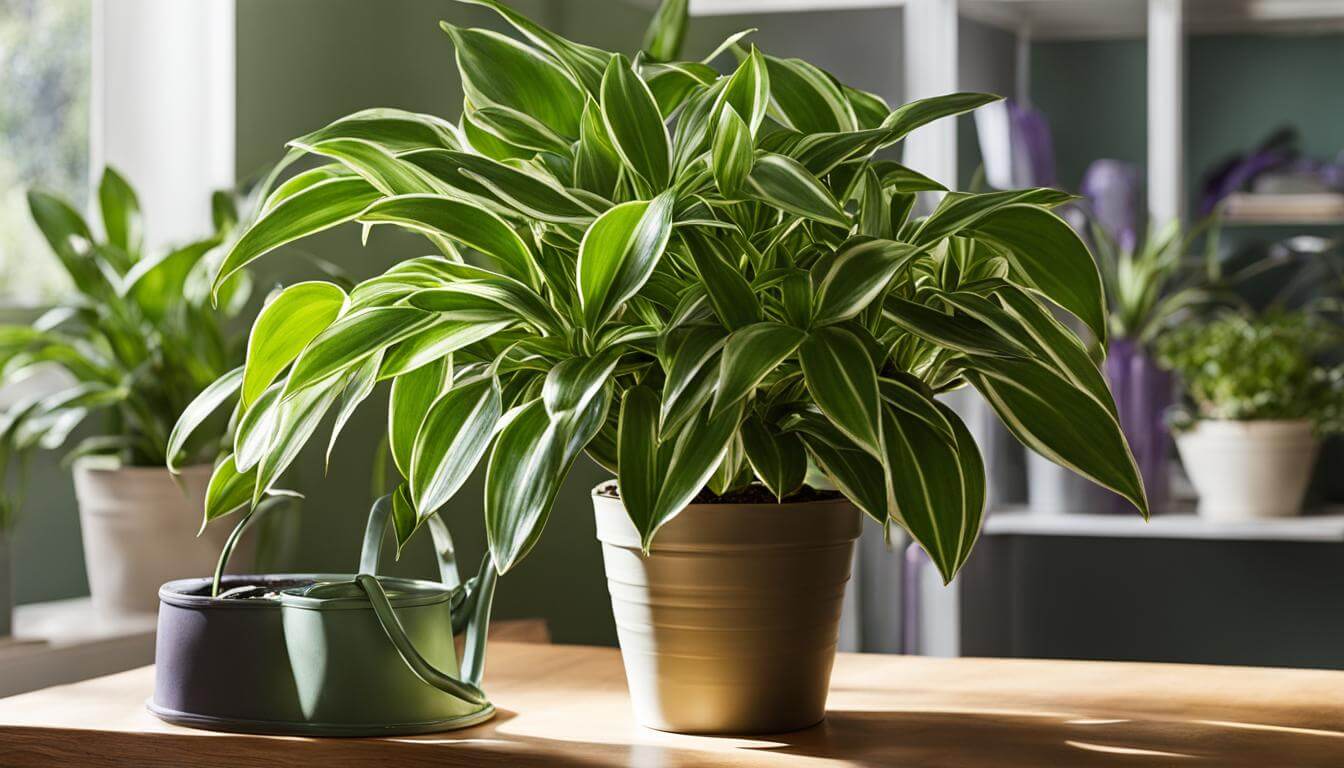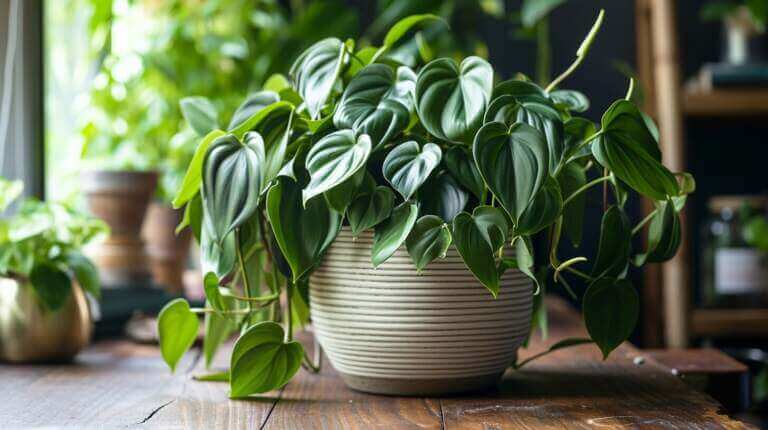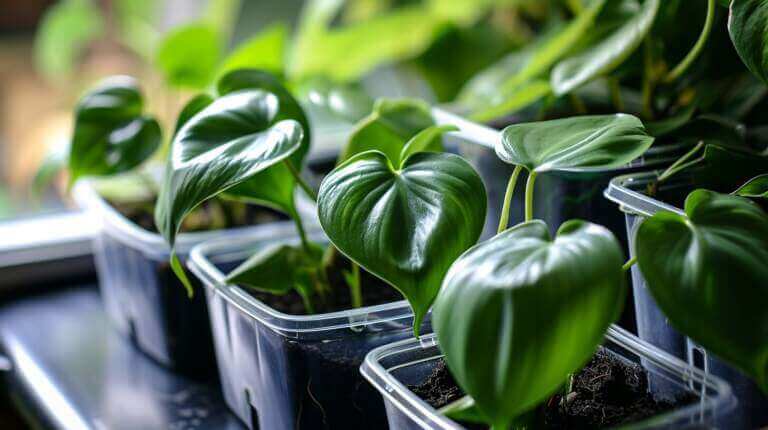As an avid plant lover, I understand the importance of providing proper care and attention to our green companions. Today, I want to share with you a comprehensive care guide for the Inch Plant Tradescantia. Whether you’re a beginner or a seasoned plant enthusiast, this guide will help you understand the light, water, and soil requirements necessary to keep your Inch Plant thriving.
Key Takeaways:
- Provide bright indirect light for your Inch Plant Tradescantia, with at least 8 hours per day being ideal.
- Keep the soil consistently moist, but not soggy, to avoid root rot.
- Choose well-draining soil to ensure proper growth and prevent waterlogged roots.
- Maintain temperatures between 60-80°F for optimal growth.
- Increase humidity levels or place your Inch Plant in naturally humid environments to promote healthy foliage.
Light Requirements for Inch Plant Tradescantia
Inch Plants, also known as Tradescantia, require sufficient light to thrive and maintain their vibrant variegated leaves. The right amount of light is crucial for the health and growth of these plants. Here’s what you need to know about the light requirements for your Inch Plant Tradescantia.
Bright Indirect Light
Inch Plants thrive in bright indirect light. They need exposure to natural light, but direct sunlight should be avoided as it can scorch their leaves and cause damage. Placing your Inch Plant near an east or west-facing window is ideal as it provides the right amount of sunlight without being too intense. If your home doesn’t have adequate natural light, you can supplement it with grow lights to ensure your plant receives the necessary light it requires.
Variegated Leaves and Low Light Settings
The variegation in Inch Plant Tradescantia leaves is a beautiful characteristic that adds to their appeal. However, insufficient light can cause the variegation to fade or become less pronounced. If your Inch Plant is placed in a low light setting, it may not develop vibrant variegated leaves. To maintain the beauty of the variegation, ensure your plant receives at least 8 hours of bright indirect light each day.
Summary:
- Inch Plants require bright indirect light to thrive.
- Avoid direct sunlight as it can damage the leaves.
- Place your Inch Plant near an east or west-facing window to provide the right amount of light.
- Supplement with grow lights if natural light is insufficient.
- Variegated leaves may fade in low light settings.
- Ensure your plant receives at least 8 hours of bright indirect light per day.
Table: Light Requirements for Inch Plant Tradescantia
| Light Requirement | Details |
|---|---|
| Bright Indirect Light | Provide your Inch Plant with bright indirect light for optimal growth and health. |
| Avoid Direct Sunlight | Direct sunlight can scorch the leaves and cause damage. |
| East or West-Facing Window | Place your Inch Plant near a window that receives indirect sunlight from the east or west. |
| Supplement with Grow Lights | If your home lacks natural light, use grow lights to provide the necessary light requirements. |
| Variegated Leaves and Low Light | Poor light conditions can result in faded or less vibrant variegation. |
| Minimum 8 Hours of Bright Indirect Light | Ensure your Inch Plant receives at least 8 hours of bright indirect light each day. |
Watering Needs for Inch Plant Tradescantia
Proper watering is essential for the health and well-being of your Inch Plant Tradescantia. It is important to understand the watering needs of this houseplant to ensure its growth and longevity. The key to watering your Inch Plant is to maintain consistent moisture in the soil while allowing it to dry out slightly between waterings.
The general rule of thumb is to water your Inch Plant when the top couple of inches of soil feel dry to the touch. Insert your finger into the soil and if it feels dry, it’s time to water. Overwatering can lead to root rot, so it’s important to avoid keeping the soil excessively wet or soggy. On the other hand, letting the soil dry out completely can cause the plant to wilt and suffer from dehydration.
When watering your Inch Plant, thoroughly saturate the soil until water drains out from the bottom of the pot. This ensures that the entire root system receives moisture. Allow any excess water to drain away and remove any standing water from the saucer to prevent waterlogging.
| Watering Tips for Inch Plant Tradescantia | Frequency | Volume |
|---|---|---|
| Watering Frequency | Water when the top couple of inches of soil are dry | Thoroughly saturate the soil |
| Watering Volume | Ensure water drains out from the bottom of the pot | Avoid waterlogging and standing water |
During the winter months when the Inch Plant is in its dormant phase, it may require less frequent watering. Monitor the soil moisture levels and adjust your watering schedule accordingly. Always remember that it’s better to underwater than overwater your Inch Plant, as it is more tolerant of dry conditions than excessive moisture.
Soil Requirements for Inch Plant Tradescantia
Inch Plants, also known as Tradescantia, thrive in loose, well-draining, and nutrient-rich potting soil. The right soil composition plays a crucial role in the overall health and growth of these plants. It’s important to choose a well-draining potting mix that allows excess water to flow through while retaining enough moisture for the roots to absorb.
Most pre-mixed soils available in gardening stores will suffice for inch plants. These typically contain a balanced blend of organic matter, sand, and perlite to ensure proper drainage. However, it’s beneficial to add organic matter such as coco-coir, peat moss, or shredded leaves to the soil as these materials improve its quality and fertility.
Table: Soil Requirements for Inch Plant Tradescantia
| Soil Requirements | Details |
|---|---|
| Drainage | The soil should be well-draining to prevent waterlogging and root rot. It should allow excess water to flow through while retaining sufficient moisture. |
| Nutrient Content | The soil should be nutrient-rich to support the plant’s growth. Pre-mixed potting soils usually contain a balanced blend of nutrients, but organic matter can further enhance the soil’s fertility. |
| Organic Matter | Addition of organic matter such as coco-coir, peat moss, or shredded leaves improves soil structure, water retention, and nutrient availability. |
Inch plants may require repotting if the soil drains too quickly, leading to dehydration. In such cases, consider transferring the plant to a compost-rich soil mixture with less drainage materials to ensure it retains moisture for longer periods.
Maintaining a suitable soil environment is essential for the health and vitality of inch plants. By providing well-draining, nutrient-rich soil with the right balance of organic matter, you can create an optimal growing environment for your Tradescantia plants.
Temperature Requirements for Inch Plant Tradescantia
In order for your Inch Plant Tradescantia to thrive, it is important to provide it with the right temperature conditions. Maintaining a comfortable room temperature is key to the plant’s overall health.
Ideal temperature range for inch plants is between 60-80°F (15-27°C). While they can tolerate a wider range of temperatures, it’s important to avoid exposing them to extreme temperature fluctuations. Sudden drops in temperature or drafts can cause leaf drop and negatively impact the plant’s growth.
To ensure your inch plant is happy and healthy, keep it away from drafty windows, doors, and heating units. If you choose to grow your inch plant outdoors during the warmer months, make sure to bring it back indoors before the temperature drops below 50°F (10°C) at night.
Providing your inch plant with the right temperature conditions will help it thrive and maintain its beautiful foliage. Always aim for a comfortable room temperature and avoid exposing the plant to extreme temperature fluctuations.
| Temperature Requirements for Inch Plant Tradescantia | Comfortable Room Temperature | Avoid Extreme Temperature Fluctuations |
|---|---|---|
| Ideal temperature range | 60-80°F (15-27°C) | Avoid sudden drops in temperature or drafts |
| Outdoor exposure | Bring indoors before temperature drops below 50°F (10°C) at night | Avoid exposure to extreme cold or frost |
Humidity Requirements for Inch Plant Tradescantia
Proper humidity levels are essential for the optimal growth of inch plant tradescantia. These plants thrive in naturally humid environments, such as bathrooms and kitchens. However, if the humidity in your home is low, there are ways to increase moisture around the plant.
One effective method is to use a humidifier near the inch plant. This device releases moisture into the air, creating a more humid environment. Another option is to place the plant on a pebble tray filled with water. As the water evaporates, it increases the humidity around the plant. Make sure the bottom of the pot is not submerged in water to prevent root rot.
Monitoring the leaves of the inch plant can help you determine if the humidity level is adequate. Dry and browning leaves are signs of low humidity. By providing the necessary humidity, you can ensure that your inch plant tradescantia remains healthy and vibrant.
Benefits of Adequate Humidity
Maintaining proper humidity levels for your inch plant tradescantia offers several benefits. Firstly, it helps prevent leaf browning and drying, keeping the foliage lush and vibrant. Secondly, adequate humidity promotes healthy growth by providing the plant with the moisture it needs to thrive.
Furthermore, humidity can aid in reducing common issues such as spider mites and mealybugs, which tend to thrive in dry environments. By maintaining the appropriate humidity, you can create an inhospitable environment for these pests.
| Humidity Requirements for Inch Plant Tradescantia | Humidity Level |
|---|---|
| Naturally Humid Environments | 60-70% humidity |
| Using a Humidifier | 40-50% humidity |
| Pebble Tray Method | 30-40% humidity |
Remember to monitor the humidity levels regularly and adjust accordingly to ensure the best growing conditions for your inch plant tradescantia.
Fertilizing Inch Plant Tradescantia
Proper fertilization is essential for the health and growth of Inch Plant Tradescantia. By providing the right nutrients, you can ensure that your plant thrives and remains vibrant. It is important to note that Tradescantia plants do not require frequent feeding, as they are relatively low-maintenance. However, providing a diluted liquid fertilizer can benefit their growth, especially during the active growing season.
When fertilizing Inch Plant Tradescantia, it is crucial to use a diluted fertilizer. A ¼-strength solution is ideal to avoid overfeeding, as this can lead to nutrient deficiencies or even burn the plant’s delicate roots. Dilute the fertilizer according to the manufacturer’s instructions, and apply it monthly during the spring and summer months when the plant is actively growing.
During the fall and winter, it is best to hold off on fertilizing Inch Plant Tradescantia. As the plant’s growth slows down during these seasons, it requires less nutrients. By reducing or stopping the fertilization during the dormant period, you can prevent the risk of overfeeding and ensure the plant remains healthy.
In conclusion, fertilizing Inch Plant Tradescantia is an important part of its care routine. By following a monthly fertilization schedule with a diluted liquid fertilizer during the growing season, you can provide the necessary nutrients for the plant’s growth and vitality. Remember to adjust the fertilization schedule during the fall and winter months to accommodate the plant’s dormant period. By properly fertilizing your Inch Plant Tradescantia, you can enjoy its beautiful foliage and vibrant growth for years to come.
Propagation and Pruning Tips for Inch Plant Tradescantia
Propagating and pruning the Inch Plant, also known as Tradescantia, is a simple and rewarding process. By following these tips, you can maintain compact growth, prevent leggy growth, and encourage new growth.
Propagation
One of the easiest ways to propagate an Inch Plant is through stem cuttings. Simply take a healthy stem cutting, about 4-6 inches long, and remove the lower leaves. Place the cutting in a glass of water or directly into moist soil. Within a few weeks, roots will develop, and you can transfer the new plant to its permanent location.
Pruning
To maintain a compact and bushy appearance, regular pruning is essential. Start by pinching back the tips of the vines, which will encourage new growth and prevent the plant from becoming too leggy. You can also remove any yellowed or damaged leaves to keep the plant looking fresh and healthy.
When pruning, don’t be afraid to trim back the Inch Plant more severely if it has become too long or straggly. By cutting back the stems, you will stimulate new growth and help the plant maintain a more compact shape.
Remember, the sections you remove during pruning can be used to propagate new plants. This is a great way to expand your Inch Plant collection and ensure the continued fullness of your existing plants.
FAQ
What are the light requirements for Inch Plant Tradescantia?
Inch Plants require bright indirect light to thrive. They can handle a range of light conditions, but direct sunlight can burn their leaves and diminish the variegation. Ideally, they should receive at least 8 hours of bright indirect light per day. In low light settings, the variegation may fade or diminish. Placing the plant in an east or west-facing window or using grow lights can help provide the necessary light.
How often should I water Inch Plant Tradescantia?
Tradescantia plants should be watered when the top couple of inches of soil are dry. The soil should be kept consistently moist, but not soggy. Avoid letting the soil dry out completely, as this can lead to wilting and leaf drop. During the winter months when the plant is not actively growing, it may require less water. Monitor the soil moisture to determine the best watering schedule for your inch plant.
What kind of soil does Inch Plant Tradescantia need?
Inch Plants thrive in loose, well-draining, nutrient-rich potting soil. Most pre-mixed soils will suffice, but it’s important to ensure that the soil is able to retain moisture while allowing excess water to drain to avoid root rot. Adding organic matter such as coco-coir, peat moss, or shredded leaves can help improve soil quality. If the soil drains too quickly, repotting the tradescantia into a compost-rich soil mixture with less drainage materials may be necessary.
What temperature range is suitable for Inch Plant Tradescantia?
Inch Plants prefer warmer temperatures between 60-80°F. They can tolerate a range of temperatures, but it’s important to avoid placing them near drafty windows, doors, or heating units, as sudden drops in temperature or fluctuating drafts can cause leaf drop. During the warmer months, they can be grown outdoors, but should be brought back indoors before the temperature drops below 50°F at night.
How do I provide the right humidity for Inch Plant Tradescantia?
Tradescantia plants prefer higher humidity levels to thrive. It’s beneficial to place them in naturally humid environments, such as kitchens or bathrooms. If the humidity is low, using a humidifier or a pebble tray with water can help increase the humidity around the plant. This is especially important during the winter or in dry climates. Monitoring the leaves for dryness and browning can indicate a need for increased humidity.
How often should I fertilize Inch Plant Tradescantia?
Tradescantia plants do not require frequent feeding or fertilizing. A ¼-strength diluted complete liquid fertilizer can be used monthly during the spring and summer when the plant is actively growing. It’s important to hold off on fertilizing during the fall and winter, as the plant’s growth slows down. Overfeeding can lead to nutrient deficiencies or even burn the plant’s roots, so it’s best to follow the recommended feeding schedule.
How can I propagate and prune Inch Plant Tradescantia?
Inch Plants are easy to propagate and prune. They can be propagated from stem cuttings in water or soil. Regular pruning is necessary to maintain a compact and bushy appearance, as inch plants can become leggy if they don’t receive enough light. Pinching back the tips of the vines can encourage new growth and prevent spindly growth. Sections removed during pruning can be used to propagate new plants and maintain fullness. Routinely trimming the plant will also stimulate new growth and prevent it from becoming overly leggy.







